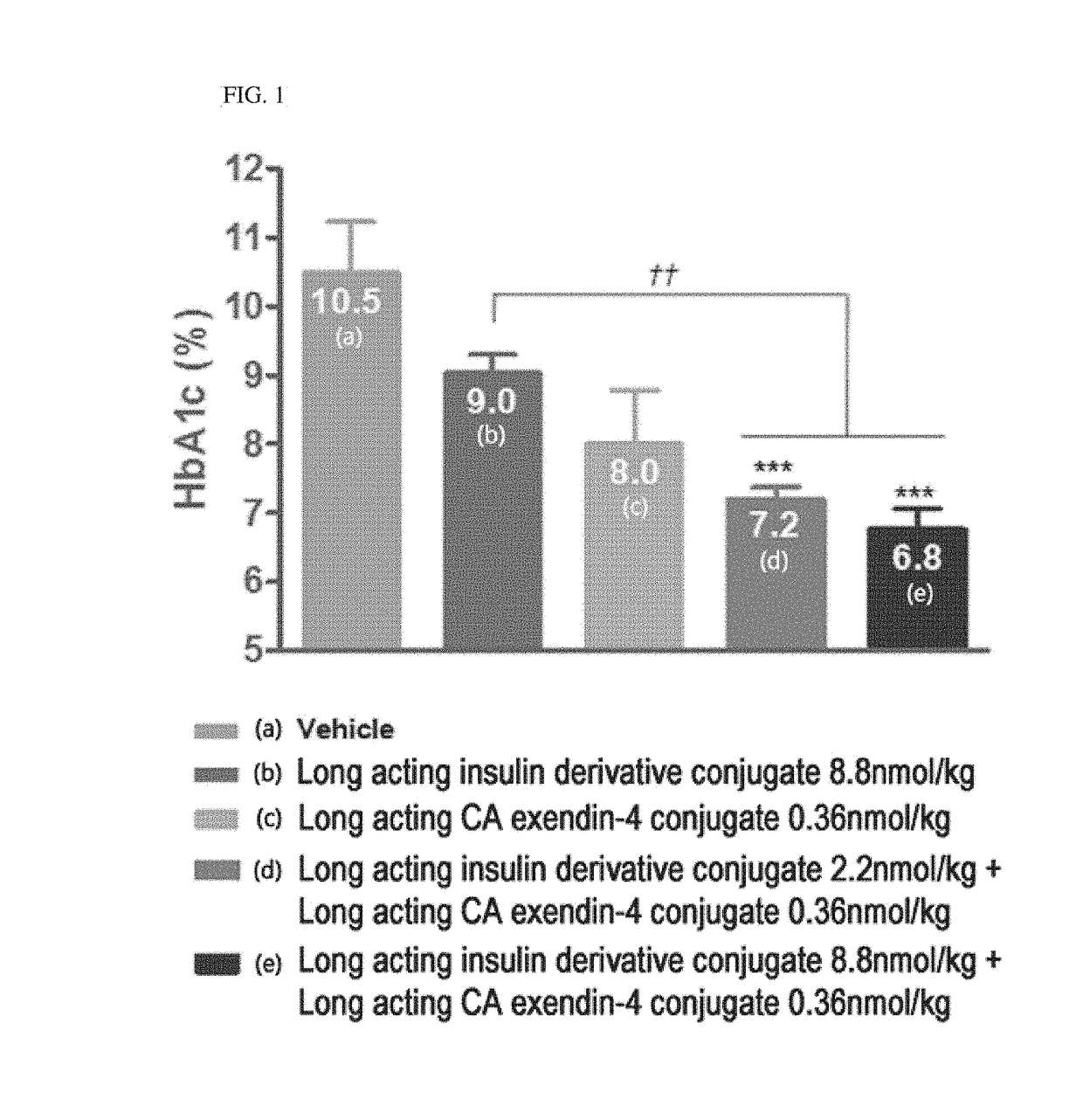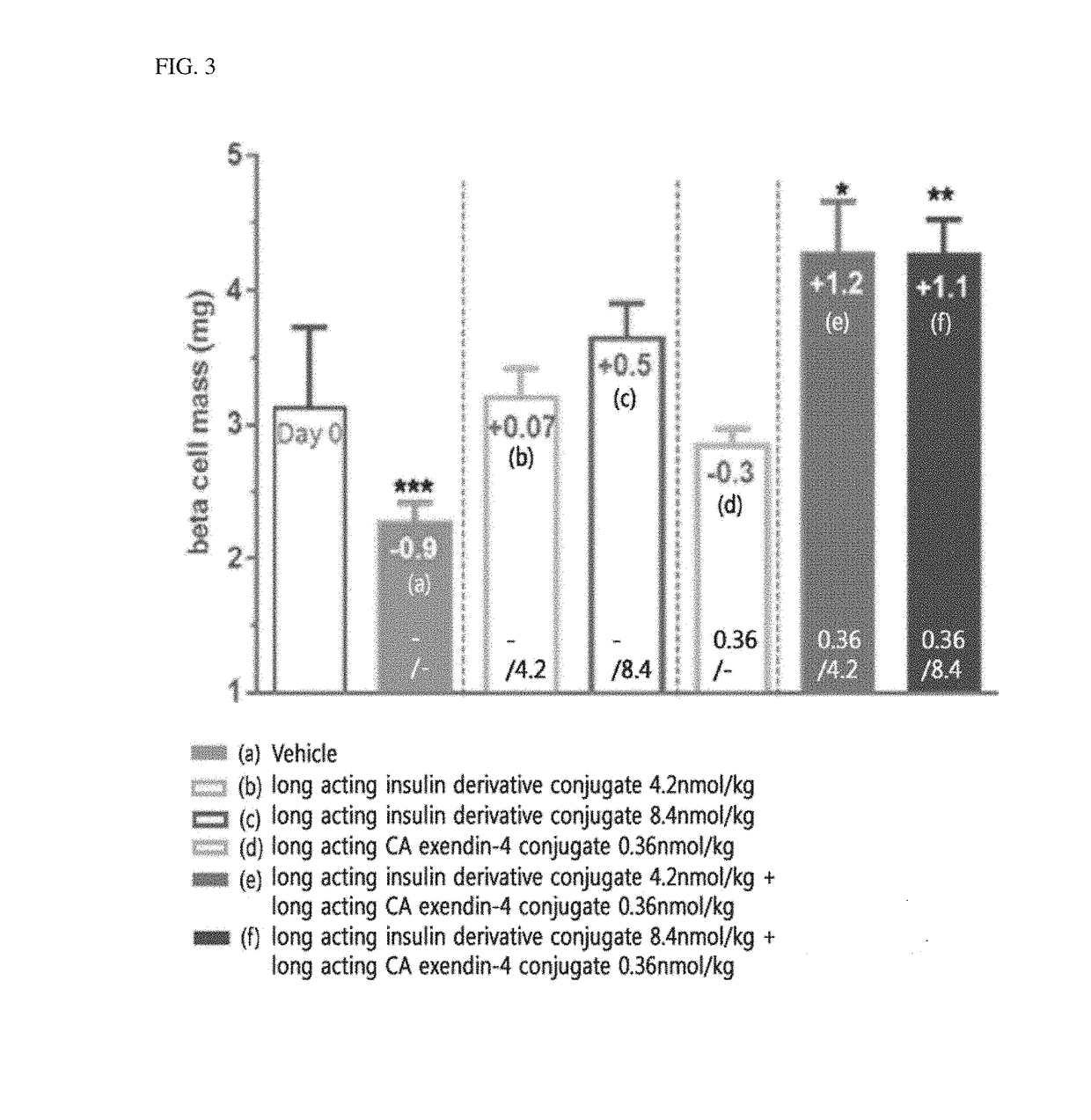Method for treating diabetes comprising long-acting insulin analogue conjugate and long-acting insulinotropic peptide conjugate
a long-acting, insulin-like technology, applied in the direction of peptide/protein ingredients, drug compositions, metabolic disorders, etc., can solve the problems of aversion to needles, difficulty in handling injection devices, hypoglycemia, weight gain, etc., to improve the in vivo duration of the efficacy and stability of insulin, improve the effect of diabetes treatment, and stabilize the blood glucose control
- Summary
- Abstract
- Description
- Claims
- Application Information
AI Technical Summary
Benefits of technology
Problems solved by technology
Method used
Image
Examples
example 1
on of Single Chain Insulin Analogue Expression Vector
[0124]In order to prepare insulin analogues (analog), each analogue having a variant of one amino acid in A chain or B chain, using the available native insulin expression vector as a template, forward and reverse oligonucleotides were synthesized (Table 2), and PCR was performed to amplify respective analogue genes.
[0125]Each of the amino acid sequences modified in A chain or B chain and each name of the analogues are given in the following Table 1. That is, analogue 1 has a substitution of alanine for glycine at position 1 of A chain, and analogue 4 has a substitution of alanine for glycine at position 8 of B chain.
[0126]
TABLE 1AnalogModifed sequenceAnalog 1A1G → AAnalog 2A2I → AAnalog 3A19Y → AAnalog 4B8G → AAnalog 5B23G → AAnalog 6B24F → AAnalog 7B25F → AAnalog 8A14Y → EAnalog 9A14Y → N
[0127]Primers for insulin analogue amplification are given in the following Table 2.
[0128]
TABLE 21AnalogSequenceSEQ ID NOAnalog 15′ GGGTCCCTGCA...
example 2
n of Recombinant Insulin Analogue Fusion Peptides
[0132]Recombinant insulin analogues were expressed under control of T7 promoter. E. coli BL21-DE3 (E. coli B F-dcm ompT hsdS(rB-mB-) gal DE3); Novagen) was transformed with each of the recombinant insulin analogue expression vectors. Transformation was performed in accordance with the procedures recommended by Novagen. Single colonies transformed with the respective recombinant expression vectors were inoculated in ampicillin (50 / ml)-containing 2× Luria Broth (LB) medium, and cultured at 37° C. for 1.5 hours. Each culture broth of the recombinant strain and 30% glycerol-containing 2× LB medium were mixed at a ratio of 1:1(v / v), and each 1 ml thereof was dispensed to a cryotube, and stored at −140° C. These samples were used as cell stocks for production of the recombinant fusion proteins.
[0133]To express recombinant insulin analogues, each 1 vial of the cell stocks was thawed and inoculated in 500 ml of 2× Luria Broth, and cultured un...
example 3
nd Refolding of Recombinant Insulin Analogues
[0134]In order to convert the recombinant insulin analogues expressed in Example 2 into soluble forms, cells were disrupted, followed by refolding. 100 g (wet weight) of the cell pellet was re-suspended in 1 L of lysis buffer (50 mM Tris-HCl (pH 9.0), 1 mM EDTA (pH 8.0), 0.2 M NaCl and 0.5% Triton X-100). The cells were disrupted using a microfluidizer processor M-110EH (AC Technology Corp. Model M1475C) at an operating pressure of 15,000 psi. The cell lysate thus disrupted was centrifuged at 7,000 rpm and 4° C. for 20 minutes. The supernatant was discarded and the pellet was re-suspended in 3 L of washing buffer (0.5% Triton X-100 and 50 nmol Tris-HCl (pH 8.0), 0.2 M NaCl, 1 mM EDTA). After centrifugation at 7,000 rpm and 4° C. for 20 minutes, the cell pellet was re-suspended in distilled water, followed by centrifugation in the same manner. The pellet thus obtained was re-suspended in 400 ml of buffer (1 M Glycine, 3.78 g Cysteine-HCl, ...
PUM
| Property | Measurement | Unit |
|---|---|---|
| molecular weight | aaaaa | aaaaa |
| molecular weight | aaaaa | aaaaa |
| operating pressure | aaaaa | aaaaa |
Abstract
Description
Claims
Application Information
 Login to View More
Login to View More - R&D
- Intellectual Property
- Life Sciences
- Materials
- Tech Scout
- Unparalleled Data Quality
- Higher Quality Content
- 60% Fewer Hallucinations
Browse by: Latest US Patents, China's latest patents, Technical Efficacy Thesaurus, Application Domain, Technology Topic, Popular Technical Reports.
© 2025 PatSnap. All rights reserved.Legal|Privacy policy|Modern Slavery Act Transparency Statement|Sitemap|About US| Contact US: help@patsnap.com



